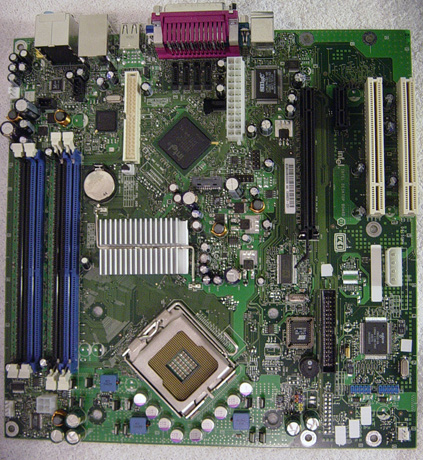Intel's Long Awaited BTX Form Factor
by Purav Sanghani on November 15, 2004 5:31 AM EST- Posted in
- Cases/Cooling/PSUs
Examining BTX cont'd
The D915GMH is essentially a microBTX version of our D915GUX motherboard with a few functional differences on top of the obvious BTX design. When we first laid eyes on the D915GMH the first thing we noticed was the arrangement of the CPU socket, Northbridge, and Southbridge. The CPU socket is placed at the front of the motherboard with the Northbridge behind it slightly to the left and the Southbridge behind the Northbridge directly in line with the CPU socket. Each is positioned on a diagonal which we assume will improve air flow around all three chips. Since these components are three of the hottest running components in a PC it made sense to position them in line from front to back and we expect fans to be placed in that same linear arrangement.A design that revolves so much around irregularly placed components was slightly unusual for us to see. Although software dictates the exact routing of all the traces from component to component, its very obvious that some very complicated math went into assuring each bridge and component was placed correctly. The fact that almost nothing seems to be at a right angle is a little overwhelming at first.
The IDE and Floppy ribbon headers were separated on the board. We found this to be inefficient, especially for the floppy drive, since they are on opposite sides of the system. Though not as important nowadays since SATA drives are moving into mainstream PCs, those who would like to use floppy drives are left with only the option of using a lengthy rounded cable. Since the AOpen/Intel combination we received today looks more like an OEM design than something we would typically buy and assemble from NewEgg, problems with the floppy cable placement shouldn't be a huge issue.

Click to Enlarge
There are 4 DDR memory sockets which are placed at the far left edge of the board. Keep in mind our D915GMH runs on DDR2, but other than design layout that is the only major difference between our microATX and microBTX motherboards.

Click to Enlarge
The PCIe x16 slot is positioned about 3 inches from the rightmost edge of the D915GMH. Since the AOpen B300 is a half height case a riser card is included for the PCIe x16 slot. This allows the VGA card to be mounted towards the center of the motherboard to keep it inline with the CPU and chipset.










77 Comments
View All Comments
DerekBaker - Monday, November 15, 2004 - link
#25From here I should think: ">From the picture we see the flow of warm air pulled forward from beyond the VGA card. As it moves towards the front of the case the air flows over the Southbridge and Northbridge passively cooling each chip. We then see from the shades of red the air warms up as it flows through the CPU heatsink then begins to cool as it moves out the front of the case."
http://www.anandtech.com/casecooling/showdoc.aspx?...
Derek
Oxonium - Monday, November 15, 2004 - link
Let's see, a new form factor with new case requirements and STILL no standardized connector for the front Power/Reset/LED's/etc.? I'm all for cooler cases, but a standardized connector for those items is something that should have been implemented years ago.HardwareD00d - Monday, November 15, 2004 - link
#24, who cares since athlons run much cooler and don't need this case form factor.Doormat - Monday, November 15, 2004 - link
I heard a rumor that it wont work with Athlon 64 chips or any type of chip that has the memory controller integrated with the processor, because the distance between the processor and the RAM banks are too far. Anyone confirm this?Superbike - Monday, November 15, 2004 - link
Wow AT is back.phisrow - Monday, November 15, 2004 - link
While I agree that the tweaky enthusiast market doesn't have much to gain at the moment by moving from ATX to BTX, especially as most of them are running A64s or praying-for-death overclocked mobile Athlons, I think there is certainly something to be said for the form-factor. It does seem to be more efficient for cooling than your average ATX(especially for small cases). Even if you are running some PentiumM or a derivative thereof, more efficient is still better. After all, if a given case design can cool a high-end Prescott without deafening its user, it can probably cool a brutally overclocked Pentium M with its fans running at half the speed. For that matter, if the trace length issues aren't actually crippling, I would like to see some A64 motherboards in this format.johnsonx - Monday, November 15, 2004 - link
Visualize an office full of MicroBTX Desktop computers. Visualize the women in the office cupping their hands around the heat exhaust... visualize the overclocking tips flowing around the female staff as they strive to increase heat output... visualize the men pouring sweat, desparately trying to duct-tape the front vent to block the hot Intel Air.I'm sorry, but any spec that seeks to exhaust hot air out the FRONT of any case, whether it be a desktop, tower or SFF, is just plain STUPID.
araczynski - Monday, November 15, 2004 - link
my god, after all these years, they fall back on the packard bell mentality...KristopherKubicki - Monday, November 15, 2004 - link
GTMan: Temperatures were certainly taken with the cases closed.Kristopher
GTMan - Monday, November 15, 2004 - link
I wonder if all those temperature measurements were done with the case open? I would think a case designed for efficient air flow would only perform properly (as designed) when fully assembled!!!